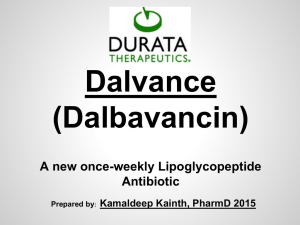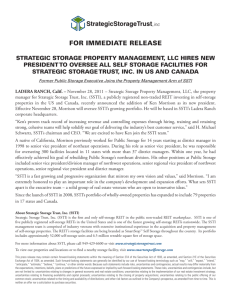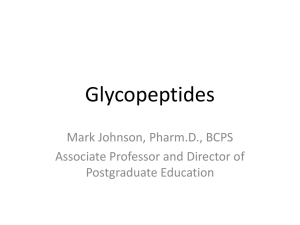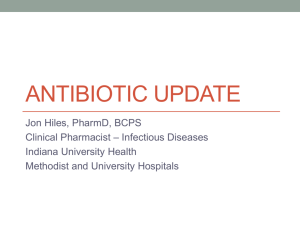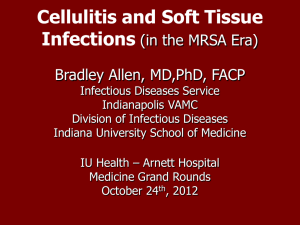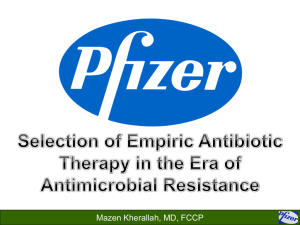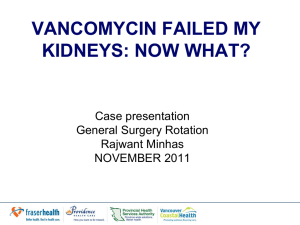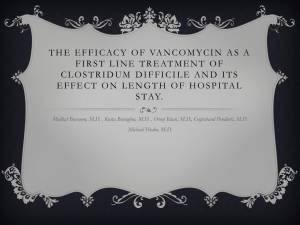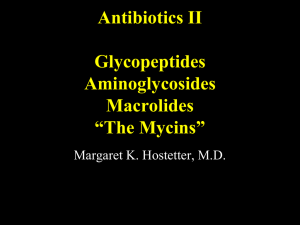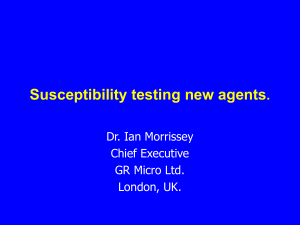Case History: Question - What`s New in Medicine
advertisement
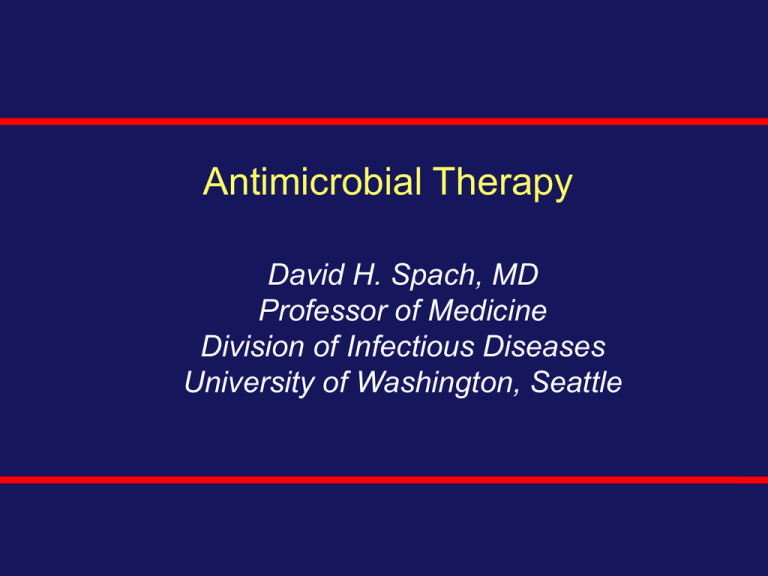
Antimicrobial Therapy David H. Spach, MD Professor of Medicine Division of Infectious Diseases University of Washington, Seattle Use of Antimicrobials • Treat Infections • Cost • Prevent Infections • Resistance Antibiotic Use and Resistance Community Use Hospital Use Agricultural Use Antibiotic Use and Resistance Community Use Hospital Use Agricultural Use 2014 Most Prescribed Drugs Infectious Diseases 36. Tamiflu 60. Zostavax 77. Truvada 84. Norvir 97. Atripla Source: IMS National Prescription Audit, IMS Health. 2014 Most Profitable Drugs Infectious Diseases 15. Atripla (HIV) 22. Truvada (HIV) 32. Solvaldi (Hepatitis C) 49. Prezista (HIV) 51. Isentress (HIV) 59. Reyataz (HIV) 71. Prevnar 13 (Vaccine) 75. Stribild (HIV) 81. Zyvox (Antibacterial) 84. Complera (HIV) 87. Gardasil (Vaccine) 88. Zostavax (Vaccine) 93. Cubicin (Antibacterial) 97. Viread (HIV) Source: IMS National Prescription Audit, IMS Health. Source: IDSA. Clin Infect Dis. 2010:50:1081-3. “Our audacious but noble aim is the creation of a sustainable global antibacterial drug R&D enterprise with the power in the short-term to develop 10 new, safe, and effective antibiotics by 2020.” Source: IDSA. Clin Infect Dis. 2010:50:1081-3. “ESKAPE” Pathogens Enterococcus faecalis Staphylococcus aureus Klebsiella pneumoniae Acinetobacter baumannii Pseudomonas aeruginosa Enterobacter species Structure of Gram-Positive Bacteria Penicillin Binding Proteins DNA Cell Membrane Cell Wall Structure of Gram-Negative Bacteria Outer Membrane Cell Wall Periplasmic Space Cell Membrane Porin Channel DNA Antimicrobials: Site of Action Cell Wall Cytoplasm Cell Membrane DNA Inhibitor 23 S Ribosome 30S Ribosome 50S Ribosome Systemic Antibacterials: Recent FDA Approvals 2009 -Telavancin (Vibativ): SSTI 2010 - Ceftaroline (Teflaro): SSTI, CAP 2011 - Fidaxomicin (Dificid): Clostridium difficile 2013 - Telavancin (Vibativ): HAP/VAP 2014 Tedizolid (Sivextro): SSTI Dalbavancin (Dalvance): SSTI Oritavancin (Orbactiv): SSTI Telavancin (Vibativ) Telavancin: Mechanism of Action Telavancin Cell Wall Synthesis DNA Telavancin: Mechanism of Action (1) Ligase D-Ala D-Ala Tripeptide Intermediate D-Ala D-Ala Cell Wall Pentapeptide Precursor D-Ala D-Ala Telavancin Telavancin: Mechanism of Action (2) Telavancin Lipid II (cell wall precursor) Telavancin (Vibativ) FDA Status: approved for SSTI 2009, HAP in 2013 Clinical Indication: 1) complicated SSTI caused by gram-positive bacteria (MSSA, MRSA, S. pyogenes, S. agalactiae, S. anginosus group, E. faecalis) 2) VAP and HAP caused by MSSA or MRSA Mechanism: Lipoglycopeptide vancomycin semisynthetic derivative -inhibits cell wall synthesis and binds to membrane lipid II molecules Dosing: 10 mg IV q24 hours Dose Reduction: - For CrCl 30-50: 7.5 mg/kg q24 - For CrCl 10-30: 10 mg/kg q48 Adverse Effects: nephrotoxicity, diarrhea, “red man”, foamy urine Source: Damodaron SE, Madhan S. J Pharmacol Pharmacother. 2011;2:135-7. Telavacin versus Vancomcyin for Complicated SSTI ATLAS Trial Study Design Overall Success Rate* Methods (N = 1867) Regimens - Telavancin: 10 mg/kg IV q24h - Vancomycin: 1g IV q12h 100 Vancomycin 91 86 80 Patients% - Two Phase 3 trials - Randomized, double blind - Patients with complicated SSTI - Suspected or confirmed gram+ - N = 579 with MRSA - Adults Telavancin 60 40 20 0 All *7-14 days after receipt of last antibiotic dose Source: Stryjewski ME, et al. Clin Infect Dis. 2008;46:1683-93. Telavacin versus Vancomcyin for HAP with Gram+ ATTAIN Trial Study Design Results Methods (N = 1503) Regimens (duration 7-21 days) - Telavacin: 10 mg/kg IV q24h - Vancomycin: 1g IV q12h - Concomitant therapy for Gram- allowed Vancomycin 100 82 81 80 Patients% - Two Phase 3 trials - Randomized, double blind - Patients with HAP, including VAP - Suspected or confirmed gram+ - Adults Telavancin 60 40 22 20 17 0 Cure Rate Source: Rubinstein E, et al. Clin Infect Dis. 2011;52:31-40. Mortality Ceftaroline (Teflaro) Beta-Lactams: Mechanism of Action Penicillin Binding Proteins Ceftaroline Transpeptidation Carboxypeptidation DNA Cell Membrane Cell Wall Ceftaroline (Teflaro): Mechanism of Action Altered Penicillin Binding Protein PBP 2a PBP 2a DNA Ceftaroline Ceftaroline (Teflaro) FDA Status: approved 2010 Indication: SSTI, CAP Class: Cephalosporin (“5th Generation”) Mechanism: Inhibits cell wall synthesis (binds to PBP, including PBP2a) Dose: 600 mg IV q12 hours Activity: - Broad gram-positive activity: MSSA, MRSA, VISA, DRSP - Gram-negative: Enterobacteriaceae - Not active against Pseudomonas sp. or Proteus sp., or E. faecium Adverse Effects: seroconversion to positive direct Coombs’ test Source: Saravolatz LD, et al. Clin Infect Dis. 2011;52:1156-63. Cetaroline for Complicated SSTI CANVAS 1 and 2 Study Design Clinical Cure Methods Regimens (5-14 days) Ceftaroline: 600 mg IV q12h or Vancomycin: 1g IV q12h + Aztreonam: 1 g IV q12h 100 93 92 Vancomycin-Aztreonzam 93 94 80 Patients% - Pooled analysis of 2 phase 3 trials - Double-blind trial - N = 1378 enrolled - Complicated SSTI Ceftaroline 60 40 20 0 All Source: Corey GR, et al. Clin Infect Dis. 2012;56:641-50. MRSA Cetaroline vs. Ceftriaxone for CAP Focus1 and 2 Study Design Clinical Cure Rate Methods Regimens (5-14 days) Ceftaroline: 600 mg IV q12h x 5-7d or Ceftriaxone: 1g IV q12h x 5-7d Ceftriaxone 100 84 80 Patients% - Pooled analysis of 2 phase 3 trials - Double-blind trial - N = 1228 enrolled - Community acquired pneumonia - Patients hospitalized Ceftaroline 60 40 20 0 FOCUS 1: received 2 doses of clarithromycin on d1 Source: File TM, et al. Clin Infect Dis. 2010;51:1395-405. 78 Tedizolid (Sivextro) Protein Synthesis 50 S Ribosome 30 S Ribosome 50S fMet-tRNA 23S 30S 23S 70 S Initiation Complex DNA Tedizolid (Zyvox): Mechanism of Action 50 S Ribosome Tedizolid 30 S Ribosome 50S fMet-tRNA 23S 30S DNA 23S 70 S Initiation Complex Tedizolid (Sivextro) FDA Status: approved June 20, 2014 Clinical Indication: approved for SSTI caused by susceptible bacteria MSSA, MRSA, S. pyogenes, S. agalactiae, S. anginosus group, E. faecalis Class: Oxazolidinone; binds to 23S rRNA of 50S subunit Mechanism: Inhibits protein synthesis (blocks ribosomal initiation complex) Dose: 200 mg IV or PO once daily Adverse Effects: nausea, headache, diarrhea Source: Tedizolid Package Insert Tedizolid versus Linezolid for SSTI: Oral Therapy ESTABLISH-1 Study Design (ESTABLISH-1) Early Clinical Response Methods Tedizolid 100 - Randomized, double blind, phase 3 trial - 81 study centers - Acute bacterial SSTI Regimens - Tedizolid: 200 mg PO qd x 6d 80 Patients% - N = 667 adults Linezolid 60 40 20 - Linezolid: 600 mg PO bid x 10 days 0 Source: Prokocimer P, et al. JAMA. 2013;309:559-69. 80 79 Tedizolid versus Linezolid for SSTI: IV/Oral Therapy ESTABLISH-2 Study Design (ESTABLISH-2) Early Clinical Response Methods Regimens* - Tedizolid: 200 mg IV/PO qd x 6d - Linezolid: 600 mg IV/PO bid x 10 days *required to receive IV therapy for minimum of 1 day, then could step down to PO Linezolid 100 85 80 Patients% - Randomized, double blind, phase 3 trial - 58 centers in 9 countries - N = 666 adults - Acute bacterial SSTI Tedizolid 60 40 20 0 Source: Moran GJ, et al. Lancet Infect Dis 2014;14:696-705. 83 Dalbavancin (Dalvance) Dalbavancin (Dalvance): Mechanism of Action Dalbavancin Cell Wall Synthesis Dimer Dimer DNA Dimer Dalbavancin (Dalvance) FDA Status: approved May 23, 2014 Clinical Indication: approved for SSTI caused by gram-positive bacteria (MSSA, MRSA, S. pyogenes, S. agalactiae, S. anginosus group) Mechanism: Lipoglycopeptide that inhibits cell wall synthesis 2 Dose Regimen: 1000 mg IV followed 1 week later by 500 mg IV Dose Reduction: - Regular hemodialysis: no dose change - For CrCl < 30 ml/min and no hemodialysis: 750 mg then 375 mg Adverse Effects: nausea, headache, diarrhea Source: Dalbavancin Package Insert Dalbavancin versus Vancomycin for SSTI DISCOVER 1 and DISCOVER 2 Study Design Clinical Response to Therapy Methods Regimens - Dalbavancin 1000 mg d1, 500 mg d8 - Vancomycin IV for ≥3 days, then oral linezolid 600 mg bid to complete 10-14d 100 80 Patients% - Pooled analysis of 2 phase 3 trials* - Randomized trials - N = 659 adults - Acute bacterial SSTI Dalbavancin Vancomycin-Linezolid 91 80 92 80 60 40 20 0 1° End Point *DISCOVER 1 and DISCOVER 2 2° End Point 1° End Point = Success rate at 48 to 72 hours 2° End Point = Success rate at end of therapy Source: Babinchak T, et al. Clin Infect Dis 2005;41:S354-7. How is Dalbavancin Different from Vancomycin Mechanism of Action - Improved PBP binding due to hydrophobic side chain - More stable binding due to formation of dalbavancin dimers Dalbavancin bactericidal and vancomycin bacteriostatic Differences in dosing and dose reductions Source: Guskey MT, et al. Pharmacotherapy. 2010;30:80-94. INVESTIGATIONAL-Dalbavancin not FDA approved for treatment of bloodstream infections Catheter-Related Bloodstream Infections Dalbavancin versus Vancomycin Study Design Overall Success Rate Methods (N 75) Regimens - Dalbavancin: 1.0 g IV d1; 0.5 g IV d8 - Vancomycin: 1g bid IV x 14d Vancomycin 100 87 80 Patients% - Phase 2, randomized, controlled - Patients with catheter-related BSI - Randomized, open-labeled - Catheter-related BSI cause by Gram+ - Catheters removed for MSSA & MRSA - MRSA identified in 51% of patients Dalbavancin 60 40 20 0 Source: Raad I, et al. Clin Infect Dis 2005;40:374-80. 50 Oritavancin (Orbactiv) Oritavancin (Orbactiv) FDA Status: approved August 6, 2014 Clinical Indication: approved for acute SSTI caused by gram-positive bacteria (MSSA, MRSA, various streptococcal species, and Enterococcus faecalis) Mechanism: Lipoglycopeptide with multiple mechanisms: inhibits transglycolation, inhibits transpeptidation, and disrupts cell membranes Single Dose Regimen: 1200 mg IV (infused over 3 hours) Dose Reduction: - Mild or moderate renal impairment: no dose change - Severe renal impairment or hemodialysis: unknown Adverse Effects: nausea, headache, diarrhea, vomiting Oritavancin versus Vancomycin for SSTI SOLO-I Study Design (ESTABLISH-1) Investigator-Assessed Clinical Cure Methods Oritavancin 100 - Randomized, double blind, phase 3 trial - N = 954 adults Regimens - Oritavancin: 1200 mg IV x 1 - Vancomycin: 1g IV q12h x 7-10 days 80 Patients% - Acute bacterial SSTI Vancomcyin 60 40 20 0 Source: Corey R, et al. N Engl J Med. 2013;370:2180-90. 80 80 Fidaxomicin (Dificid) Fidaxomicin (Dificid) FDA Status: Approved in May 2011 Indication: Clostridium difficile-associated diarrhea Class: macrocyclic antibiotic Mechanism: inhibits RNA polymerase and transcription Dose: 200 mg bid x 10 days In vitro C. difficile activity: 8x more active than vancomycin Absorption: Minimal oral absorption Adverse Effects: nausea, vomiting, abdominal pain Clostridium difficile : Fidaxomicin vs Vancomycin Study Design Study Design Treatment Arms Protocol - N = 629 enrolled (548 evaluated) - Double-blind, prospective, randomized trial Fidaxomicin 200 mg PO BID X 10 days - Phase 3 trial - Conducted from 2006-2008 - Age: 16 years and older - Acute symptoms of C. diff and +stool toxin - Randomized to fidaxomicin or vancomycin From: Louie TJ, et al. N Engl J Med. 2011;364:422-31. Vancomycin 125 mg PO QID x 10 days Clostridium difficile: Fidaxomicin vs Vancomycin Results 100 88.2 Fidaxomicin 85.8 Patients % 80 Vancomycin 60 40 25.3 15.4 20 P < 0.005 0 Clinical Cure* Clinical Cure = resolution of symptoms and no need for further therapy Recurrence = diarrhea and positive stool test within 4 weeks after treatment From: Louie TJ, et al. N Engl J Med. 2011;364:422-31. Recurrence^ Treatment of Gram-Negative Infections Source: Boucher HW, et al. Clin Infect Dis. 2013:56:1685-94. “Our survey demonstrates some progress in development of new antibacterial drugs that target infections caused by resistant GNB, but progress remains alarmingly elusive.” Source: Boucher HW, et al. Clin Infect Dis. 2013:56:1685-94. Source: Centers for Disease Control and Prevention (CDC) Conclusions Antibiotic development has dramatically fallen off Antibiotics are lower priority for pharmaceutical development Most recently approved antibiotics are for Gram+ infections New antibiotics with favorable dosing characteristics Huge need for antibiotics for multi-resistant gram negative pathogens
